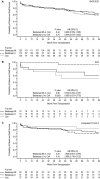Efficacy and Safety Outcomes of Extended Criteria Donor Kidneys by Subtype: Subgroup Analysis of BENEFIT-EXT at 7 Years After Transplant
- PMID: 27232116
- PMCID: PMC5215636
- DOI: 10.1111/ajt.13886
Efficacy and Safety Outcomes of Extended Criteria Donor Kidneys by Subtype: Subgroup Analysis of BENEFIT-EXT at 7 Years After Transplant
Abstract
The phase III Belatacept Evaluation of Nephroprotection and Efficacy as First-Line Immunosuppression Trial-Extended Criteria Donors Trial (BENEFIT-EXT) study compared more or less intensive belatacept-based immunosuppression with cyclosporine (CsA)-based immunosuppression in recipients of extended criteria donor kidneys. In this post hoc analysis, patient outcomes were assessed according to donor kidney subtype. In total, 68.9% of patients received an expanded criteria donor kidney (United Network for Organ Sharing definition), 10.1% received a donation after cardiac death kidney, and 21.0% received a kidney with an anticipated cold ischemic time ≥24 h. Over 7 years, time to death or graft loss was similar between belatacept- and CsA-based immunosuppression, regardless of donor kidney subtype. In all three donor kidney cohorts, estimated mean GFR increased over months 1-84 for belatacept-based treatment but declined for CsA-based treatment. The estimated differences in GFR significantly favored each belatacept-based regimen versus the CsA-based regimen in the three subgroups (p < 0.0001 for overall treatment effect). No differences in the safety profile of belatacept were observed by donor kidney subtype.
Keywords: calcineurin inhibitor: cyclosporine A (CsA); clinical research/practice; donors and donation: deceased; donors and donation: donation after circulatory death (DCD); donors and donation: extended criteria; immunosuppressant; kidney transplantation/nephrology.
© 2016 The Authors. American Journal of Transplantation published by Wiley Periodicals, Inc. on behalf of American Society of Transplant Surgeons.
Figures



Similar articles
-
Long-Term Outcomes in Belatacept- Versus Cyclosporine-Treated Recipients of Extended Criteria Donor Kidneys: Final Results From BENEFIT-EXT, a Phase III Randomized Study.Am J Transplant. 2016 Nov;16(11):3192-3201. doi: 10.1111/ajt.13830. Epub 2016 Jun 9. Am J Transplant. 2016. PMID: 27130868 Free PMC article. Clinical Trial.
-
Outcomes at 7 years post-transplant in black vs nonblack kidney transplant recipients administered belatacept or cyclosporine in BENEFIT and BENEFIT-EXT.Clin Transplant. 2018 Apr;32(4):e13225. doi: 10.1111/ctr.13225. Epub 2018 Mar 14. Clin Transplant. 2018. PMID: 29461660 Clinical Trial.
-
Posttransplant reduction in preexisting donor-specific antibody levels after belatacept- versus cyclosporine-based immunosuppression: Post hoc analyses of BENEFIT and BENEFIT-EXT.Am J Transplant. 2018 Jul;18(7):1774-1782. doi: 10.1111/ajt.14738. Epub 2018 Apr 17. Am J Transplant. 2018. PMID: 29573335 Free PMC article. Clinical Trial.
-
Should belatacept be the centrepiece of renal transplantation?Nephrol Dial Transplant. 2016 Dec;31(12):1995-2002. doi: 10.1093/ndt/gfw226. Epub 2016 Jun 10. Nephrol Dial Transplant. 2016. PMID: 27288461 Review.
-
Belatacept: in adult kidney transplant recipients.BioDrugs. 2012 Dec 1;26(6):413-24. doi: 10.2165/11208900-000000000-00000. BioDrugs. 2012. PMID: 22928660 Review.
Cited by
-
Fc-Silent Anti-CD154 Domain Antibody Effectively Prevents Nonhuman Primate Renal Allograft Rejection.Am J Transplant. 2017 May;17(5):1182-1192. doi: 10.1111/ajt.14197. Epub 2017 Feb 25. Am J Transplant. 2017. PMID: 28097811 Free PMC article.
-
Impaired renal function before kidney procurement has a deleterious impact on allograft survival in very old deceased kidney donors.Sci Rep. 2021 Jun 9;11(1):12226. doi: 10.1038/s41598-021-91843-7. Sci Rep. 2021. PMID: 34108573 Free PMC article.
-
Use of a Belatacept-based Immunosuppression for Kidney Transplantation From Donors After Circulatory Death: A Paired Kidney Analysis.Transplant Direct. 2024 Apr 11;10(5):e1615. doi: 10.1097/TXD.0000000000001615. eCollection 2024 May. Transplant Direct. 2024. PMID: 38617465 Free PMC article.
-
Cardiovascular Risk Following Conversion to Belatacept From a Calcineurin Inhibitor in Kidney Transplant Recipients: A Randomized Clinical Trial.Kidney Med. 2022 Nov 18;5(1):100574. doi: 10.1016/j.xkme.2022.100574. eCollection 2023 Jan. Kidney Med. 2022. PMID: 36593877 Free PMC article.
-
Porcine anti-human lymphocyte immunoglobulin depletes the lymphocyte population to promote successful kidney transplantation.Front Immunol. 2023 Mar 9;14:1124790. doi: 10.3389/fimmu.2023.1124790. eCollection 2023. Front Immunol. 2023. PMID: 36969156 Free PMC article.
References
-
- Wolfe RA, Ashby VB, Milford EL, Ojo AO, Ettenger RE, Held PJ, et al. Comparison of mortality in all patients on dialysis, patients on dialysis awaiting transplantation, and recipients of a first cadaveric transplant. N Engl J Med 1999; 341: 1725–1730. - PubMed
-
- Ojo AO, Hanson JA, Meier‐Kriesche H, et al. Survival in recipients of marginal cadaveric donor kidneys compared with other recipients and wait listed candidates. J Am Soc Nephrol 2001; 12: 589–597. - PubMed
-
- Niu SF, Li IC. Quality of life of patients having renal replacement therapy. J Adv Nurs 2005; 51: 15–21. - PubMed
-
- Cohen B, Smits JM, Haase B, Persijn G, Vanrenterghem Y, Frei U. Expanding the donor pool to increase renal transplantation. Nephrol Dial Transplant 2005; 20: 34–41. - PubMed
-
- Organ Procurement and Transplantation Network (OPTN) and Scientific Registry of Transplant Recipients (SRTR) . OPTN/SRTR 2012 Annual Data Report. Rockville, MD: Department of Health and Human Services, Health Resources and Services Administration; 2014. [cited 2015 Feb 4]. Available from: http://onlinelibrary.wiley.com/doi/10.1111/ajt.v14.s1/issuetoc. - DOI
Publication types
MeSH terms
Substances
LinkOut - more resources
Full Text Sources
Other Literature Sources
Medical

